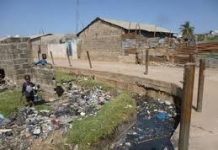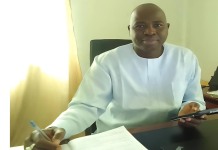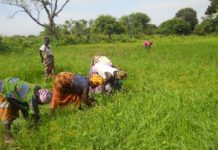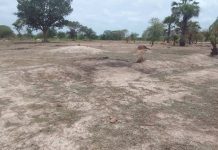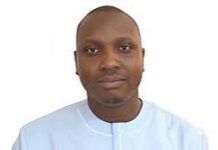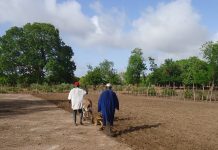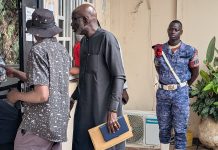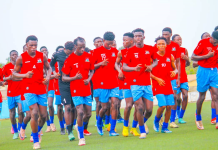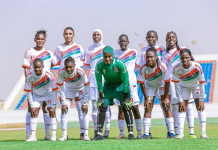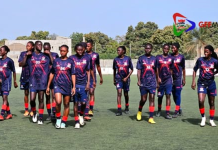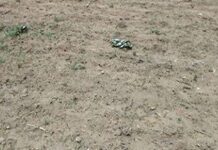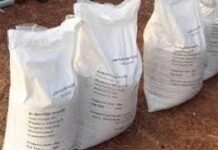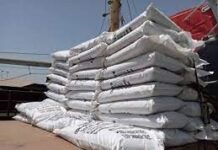 s the interventions of Government and Non-governmental Organizations.
The Draft Project Document for Action Against Desertification Project (AADP), Gambia component was validated in a forum that brought together participants from a broad cross-section of stakeholders involved in the Agriculture and Natural Resource Working Group and Platform at NaNA headquarters on the 30th July 2015.
Farmers’ Eye will share with its readers what was said in the validation to serve a food for thought as we continue to conduct social audit of this project regarding its impact in lives and livelihood of the farmers and forest users.
To begin, it is apt to note that the general objective of the Great Green Wall for Sahara and Sahel Initiative is to improve production systems’ resilience to climate change for increased food security in the circum Sahara, through actions and measures that promote and provide support to proven or innovative approaches to integrated land management and water control.
In his opening remarks, the Great Green Wall Initiative for Sahara & Sahel Initiative (GGWSSI) Focal Point, Mr. Lamin F. Jawara, mentioned that the economy in the Sahara and the Sahel is heavily dependent on agriculture, livestock and rainfall.
The Focal Point indicated that despite unfavorable agro-climatic conditions and recurrent natural disasters, agriculture and livestock are undoubtedly the cornerstones and continue to play a key role for the growth of this region.
He noted that Subsistence farming and animal husbandry, based on low-productivity and traditional techniques, are the main sources of income for rural dwellers and that the Sahel region has been identified as one of the most vulnerable to adverse effects of climate change by the Intergovernmental Panel on Climate Change (IPCC).
Mr. Lamin F. Jawara stated that Major vulnerability factors include:
– widespread poverty (an average GNP of US$ 360 per capita and per year);
– recurrent droughts that have weakened natural resources;
– heavy dependence (60 to 80% of labor force) on rain fed farming and on livestock (highly vulnerable to climate-related hazards);
– rapid population growth (with close to 3.3% population growth rate a year), with ensuing heavy pressure on the environment;
-Continuing woodland degradation due to energy needs of the population (fuel wood and related products are the main energy source for Sahel populations).
He went on to state that Erratic rainfall and severe droughts have been the most tangible effects of climate change over the past three decades throughout the Sahel region and that the entire Sahel region has been affected by net variations in rainfall over the past decades, leading to a 25 to 35 km latitudinal shift of isohyets towards the South, (which has resulted in the loss of grazing lands and acacias, as well as other fauna and flora and shifting sand dunes in the Sahel).
According to him, Climate vulnerability and change is already impacting the human and economic development in the region and that over the past forty years, the Sahel was faced with at least seven major droughts, with adverse effects on agricultural and pastoral production, food safety and local livelihoods.
Mr Jawara stated that combined with human activity, these climate-related crises have led to degradation of arable lands and depletion of pastoral resources deemed irrevocable by many observers and consequently he said, the Sahelian countries often have difficulty feeding its population and must rely on grain purchases and food aid to meet food requirements.
In this context he went on to say, African Heads of State, based on a proposal of former President of Nigeria, HE Olusegun Obasanjo, decided to join forces to combat a joint environmental problem that is having a very adverse effect on their territories, by initiating the Great Green Wall for the Sahara and the Sahel Initiative (GGWSSI).
The GGWSSI he said, offers a unique opportunity to effect significant changes in scaling up governments’ investments to promote food security and combat poverty through both policy inputs and innovative grass-roots operations that strengthen good practices in agriculture, livestock, forestry, water resources, rural infrastructure, implementation of social protection initiatives at local level in favor of household vulnerable to climate risks.
The specific added value of the GGWSSI Mr Jawara noted is to combine governance, sustainable management of land and water, production insurance and social protection against climate change, in order to secure producers’ investment and improve local livelihoods. Another important added value is linked to the fact that the programme does not focus on short term aspects of dry lands development, but supports the adoption of a medium and long term and comprehensive approach to Desertification, Land Degradation and Drought (DLDD) , climate change adaptation and mitigation, loss of biodiversity and supporting a functional coordination centered on SLM.
Based on a ‘learning by doing’ approach he said, the GGWSSI aims at increasingly applying lessons from best practices on SLM, climate resilience to development policies and practices and building its approach on on-going programmes and that regard, it is worthy to note that:
– The GGWSSI seeks effective partnerships with all stakeholders (state and non-state actors, technical and financial partners, local governments, grass-roots organizations), and introduces several innovative approaches, such as landscape approach.
– It also promotes a reorientation of development planning approaches and an intensification of SLM and resilience-related initiatives, through innovative initiatives in a cost-effective manner.
– Finally, it helps to bridge existing gaps, by integrating adaptive efforts into planning processes and development projects and by making environmental information easily accessible to all end users.
In conclusion, the Focal Point took the opportunity to thank all our development partners, especially the EU, AUC and FAO for their support in the preparation of this project document.
Mr. Kanimang Camara representing FAO country office presented the AAD Project objectives, coverage and linkages to National policies and priorities alongside FAO Strategic Objectives. Project Objectives: The overall objective of the project is to contribute to: (i) poverty alleviation; (ii) ending hunger; and (iii) improving resilience to climate change, using a landscape approach.
The specific objective of the project is to improve the condition and productivity of the agrosylvopastoral landscapes affected by Desertification, Land Degradation and Drought (DLDD) in three regions in The Gambia: North Bank Region, North of Central River Region and Upper River Region. Mr. Camara continued: the livelihoods of the rural communities will be greatly enhanced through stepwise legal transfer of forest resources and empowering them with the technical skills to manage the available resources on sustainable basis. The implementation of the activities will contribute to the efforts of controlling land degradation and deforestation processes through effective participation of local beneficiaries. Participatory approaches in the management of forest resources will be the key instruments used to ensure the sustainable management and utilization of the resources. Food insecurity, poverty and unemployment affecting negatively the livelihoods of the rural poor communities will be addressed through enhanced farm production and productivity. Climate mitigation and adaptation techniques will be among the key issues the project will address to through capacity development of the beneficiaries.
The National Consultant mentioned that, the project intends to achieve three main results:
RESULT 1: Coordination mechanisms, as well as Institutional and policy frameworks at national and local level towards sustainable and equitable Land and Forest management are improved.
RESULT 2: Local communities in the three selected landscape units have adopted and are using improved sustainable land/forest management practices and technologies.
RESULT 3: Knowledge and awareness are enhanced among key target audiences and stakeholders, including in the education sector.
He continued to present the project outcomes, outputs, activities and tentative time-bound indicators. After the presentation by the NC, groups were developed to review the project log frame and recommend for improvement. Plenary presentation of results of group work was accomplished and suggestions captured to improve the Gambia component on AAD.
For the information of the reader, the total duration of the project will be 41 months commencing October 2015 with donor contribution from ACP Secretariat/European Union/European Commission through FAO to a tune of 1.5 Million Euros.
In the Northern Regions of the River Gambia, there are a number of Sustainable Land Management (SLM) activities currently implemented alongside providing alternative sources of livelihood to the rural dwellers. Therefore, the AAD Project The Gambia component will create synergies and complementarities with on-going and up-coming initiatives on SLM in the three Regions of The Gambia. Prominent among the list of institutions involved in the activities and initiatives includes: Agency for the Development of Women and Children (ADWAC), the Forest and Farm Facility (FFF), the Department of Agriculture projects and programmes, CILSS project, PFM approaches of the Department of Forestry and FAO/ GeF Community- Based Dry Land Forest Management project, etc. The latter is slated to commence early 2016 was finally approved by the GeF secretariat. The occasion was chaired by the Deputy Director of Forestry, Mr. Malang Jassy.]]>
s the interventions of Government and Non-governmental Organizations.
The Draft Project Document for Action Against Desertification Project (AADP), Gambia component was validated in a forum that brought together participants from a broad cross-section of stakeholders involved in the Agriculture and Natural Resource Working Group and Platform at NaNA headquarters on the 30th July 2015.
Farmers’ Eye will share with its readers what was said in the validation to serve a food for thought as we continue to conduct social audit of this project regarding its impact in lives and livelihood of the farmers and forest users.
To begin, it is apt to note that the general objective of the Great Green Wall for Sahara and Sahel Initiative is to improve production systems’ resilience to climate change for increased food security in the circum Sahara, through actions and measures that promote and provide support to proven or innovative approaches to integrated land management and water control.
In his opening remarks, the Great Green Wall Initiative for Sahara & Sahel Initiative (GGWSSI) Focal Point, Mr. Lamin F. Jawara, mentioned that the economy in the Sahara and the Sahel is heavily dependent on agriculture, livestock and rainfall.
The Focal Point indicated that despite unfavorable agro-climatic conditions and recurrent natural disasters, agriculture and livestock are undoubtedly the cornerstones and continue to play a key role for the growth of this region.
He noted that Subsistence farming and animal husbandry, based on low-productivity and traditional techniques, are the main sources of income for rural dwellers and that the Sahel region has been identified as one of the most vulnerable to adverse effects of climate change by the Intergovernmental Panel on Climate Change (IPCC).
Mr. Lamin F. Jawara stated that Major vulnerability factors include:
– widespread poverty (an average GNP of US$ 360 per capita and per year);
– recurrent droughts that have weakened natural resources;
– heavy dependence (60 to 80% of labor force) on rain fed farming and on livestock (highly vulnerable to climate-related hazards);
– rapid population growth (with close to 3.3% population growth rate a year), with ensuing heavy pressure on the environment;
-Continuing woodland degradation due to energy needs of the population (fuel wood and related products are the main energy source for Sahel populations).
He went on to state that Erratic rainfall and severe droughts have been the most tangible effects of climate change over the past three decades throughout the Sahel region and that the entire Sahel region has been affected by net variations in rainfall over the past decades, leading to a 25 to 35 km latitudinal shift of isohyets towards the South, (which has resulted in the loss of grazing lands and acacias, as well as other fauna and flora and shifting sand dunes in the Sahel).
According to him, Climate vulnerability and change is already impacting the human and economic development in the region and that over the past forty years, the Sahel was faced with at least seven major droughts, with adverse effects on agricultural and pastoral production, food safety and local livelihoods.
Mr Jawara stated that combined with human activity, these climate-related crises have led to degradation of arable lands and depletion of pastoral resources deemed irrevocable by many observers and consequently he said, the Sahelian countries often have difficulty feeding its population and must rely on grain purchases and food aid to meet food requirements.
In this context he went on to say, African Heads of State, based on a proposal of former President of Nigeria, HE Olusegun Obasanjo, decided to join forces to combat a joint environmental problem that is having a very adverse effect on their territories, by initiating the Great Green Wall for the Sahara and the Sahel Initiative (GGWSSI).
The GGWSSI he said, offers a unique opportunity to effect significant changes in scaling up governments’ investments to promote food security and combat poverty through both policy inputs and innovative grass-roots operations that strengthen good practices in agriculture, livestock, forestry, water resources, rural infrastructure, implementation of social protection initiatives at local level in favor of household vulnerable to climate risks.
The specific added value of the GGWSSI Mr Jawara noted is to combine governance, sustainable management of land and water, production insurance and social protection against climate change, in order to secure producers’ investment and improve local livelihoods. Another important added value is linked to the fact that the programme does not focus on short term aspects of dry lands development, but supports the adoption of a medium and long term and comprehensive approach to Desertification, Land Degradation and Drought (DLDD) , climate change adaptation and mitigation, loss of biodiversity and supporting a functional coordination centered on SLM.
Based on a ‘learning by doing’ approach he said, the GGWSSI aims at increasingly applying lessons from best practices on SLM, climate resilience to development policies and practices and building its approach on on-going programmes and that regard, it is worthy to note that:
– The GGWSSI seeks effective partnerships with all stakeholders (state and non-state actors, technical and financial partners, local governments, grass-roots organizations), and introduces several innovative approaches, such as landscape approach.
– It also promotes a reorientation of development planning approaches and an intensification of SLM and resilience-related initiatives, through innovative initiatives in a cost-effective manner.
– Finally, it helps to bridge existing gaps, by integrating adaptive efforts into planning processes and development projects and by making environmental information easily accessible to all end users.
In conclusion, the Focal Point took the opportunity to thank all our development partners, especially the EU, AUC and FAO for their support in the preparation of this project document.
Mr. Kanimang Camara representing FAO country office presented the AAD Project objectives, coverage and linkages to National policies and priorities alongside FAO Strategic Objectives. Project Objectives: The overall objective of the project is to contribute to: (i) poverty alleviation; (ii) ending hunger; and (iii) improving resilience to climate change, using a landscape approach.
The specific objective of the project is to improve the condition and productivity of the agrosylvopastoral landscapes affected by Desertification, Land Degradation and Drought (DLDD) in three regions in The Gambia: North Bank Region, North of Central River Region and Upper River Region. Mr. Camara continued: the livelihoods of the rural communities will be greatly enhanced through stepwise legal transfer of forest resources and empowering them with the technical skills to manage the available resources on sustainable basis. The implementation of the activities will contribute to the efforts of controlling land degradation and deforestation processes through effective participation of local beneficiaries. Participatory approaches in the management of forest resources will be the key instruments used to ensure the sustainable management and utilization of the resources. Food insecurity, poverty and unemployment affecting negatively the livelihoods of the rural poor communities will be addressed through enhanced farm production and productivity. Climate mitigation and adaptation techniques will be among the key issues the project will address to through capacity development of the beneficiaries.
The National Consultant mentioned that, the project intends to achieve three main results:
RESULT 1: Coordination mechanisms, as well as Institutional and policy frameworks at national and local level towards sustainable and equitable Land and Forest management are improved.
RESULT 2: Local communities in the three selected landscape units have adopted and are using improved sustainable land/forest management practices and technologies.
RESULT 3: Knowledge and awareness are enhanced among key target audiences and stakeholders, including in the education sector.
He continued to present the project outcomes, outputs, activities and tentative time-bound indicators. After the presentation by the NC, groups were developed to review the project log frame and recommend for improvement. Plenary presentation of results of group work was accomplished and suggestions captured to improve the Gambia component on AAD.
For the information of the reader, the total duration of the project will be 41 months commencing October 2015 with donor contribution from ACP Secretariat/European Union/European Commission through FAO to a tune of 1.5 Million Euros.
In the Northern Regions of the River Gambia, there are a number of Sustainable Land Management (SLM) activities currently implemented alongside providing alternative sources of livelihood to the rural dwellers. Therefore, the AAD Project The Gambia component will create synergies and complementarities with on-going and up-coming initiatives on SLM in the three Regions of The Gambia. Prominent among the list of institutions involved in the activities and initiatives includes: Agency for the Development of Women and Children (ADWAC), the Forest and Farm Facility (FFF), the Department of Agriculture projects and programmes, CILSS project, PFM approaches of the Department of Forestry and FAO/ GeF Community- Based Dry Land Forest Management project, etc. The latter is slated to commence early 2016 was finally approved by the GeF secretariat. The occasion was chaired by the Deputy Director of Forestry, Mr. Malang Jassy.]]>
